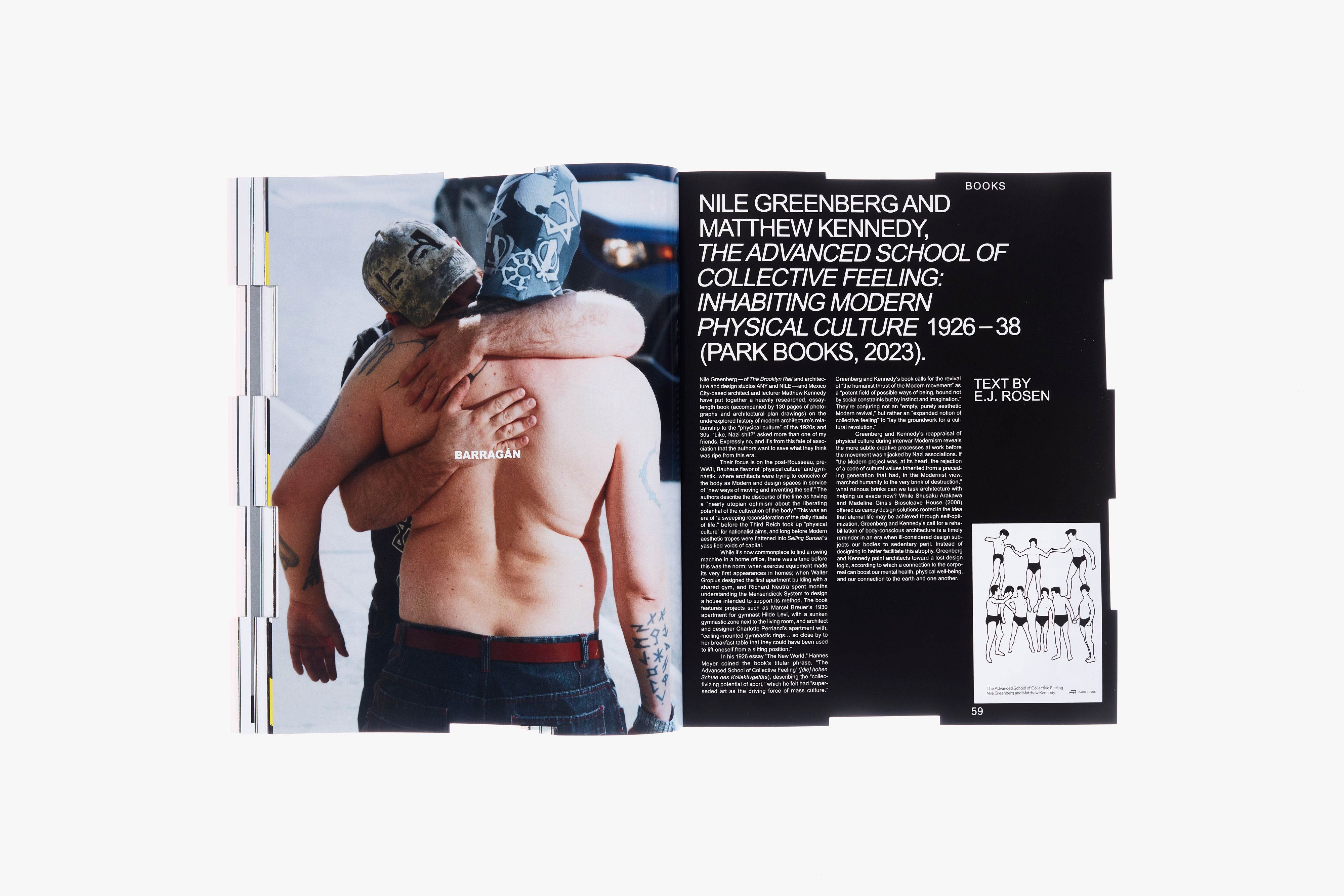PHYSICAL REVOLUTION
Niles Greenberg and Matthew Kennedy’s The Advanced School of Collective Feeling
by E.J. Rosen
Spread photographed by Luke Libera Moore.
Nile Greenberg — of The Brooklyn Rail and architecture and design studios ANY and NILE — and Mexico City–based architect and lecturer Matthew Kennedy have put together a heavily researched, essay-length book (accompanied by 130 pages of photographs and architectural plan drawings) on the underexplored history of modern architecture’s relationship to the “physical culture” of the 1920s and ‘30s. “Like, Nazi shit?” asked more than one of my friends. Expressly no, and it’s from this fate of association that the authors want to save what they think was ripe from this era.
Their focus is on the post-Rousseau, pre-WWII, Bauhaus flavor of “physical culture” and gymnastik, where architects were trying to conceive of the body as modern and design spaces in service of “new ways of moving and inventing the self.” The authors describe the discourse of the time as having a “nearly utopian optimism about the liberating potential of the cultivation of the body.” This was an era of “a sweeping reconsideration of the daily rituals of life,” before the Third Reich took up “physical culture” for nationalist aims, and long before modern aesthetic tropes were flattened into Selling Sunset’s yassified voids of capital.
While it’s now commonplace to find a rowing machine in a home office, there was a time before this was the norm; when exercise equipment made its very first appearances in homes; when Walter Gropius designed the first apartment building with a shared gym, and Richard Neutra spent months understanding the Mensendieck System to design a house intended to support its method. The book features projects such as Marcel Breuer’s 1930 apartment for gymnast Hilde Levi, with a sunken gymnastic zone next to the living room, and architect and designer Charlotte Perriand’s apartment with, “ceiling-mounted gymnastic rings…so close by to her breakfast table that they could have been used to lift oneself from a sitting position.”
In his 1926 essay “The New World,” Hannes Meyer coined the book’s titular phrase, “The Advanced School of Collective Feeling” ([die] hohen Schule des Kollektivgefüls), describing the “collectivizing potential of sport,” which he felt had “superseded art as the driving force of mass culture.” Greenberg and Kennedy’s book calls for the revival of “the humanist thrust of the modern movement” as a “potent field of possible ways of being, bound not by social constraints but by instinct and imagination.” They’re conjuring not an “empty, purely aesthetic modern revival,” but rather an “expanded notion of collective feeling” to “lay the groundwork for a cultural revolution.”
Greenberg and Kennedy’s reappraisal of physical culture during interwar Modernism reveals the more subtle creative processes at work before the movement was hijacked by Nazi associations. If “the modern project was, at its heart, the rejection of a code of cultural values inherited from a preceding generation that had, in the modernist view, marched humanity to the very brink of destruction,” what ruinous brinks can we task architecture with helping us evade now? While Shusaku Arakawa and Madeline Gins’s Bioscleave House offered us campy design solutions rooted in the idea that eternal life may be achieved through self-optimization, Greenberg and Kennedy’s call for a rehabilitation of body-conscious architecture is a timely reminder in an era when ill-considered design subjects our bodies to sedentary peril. Instead of designing to better facilitate this atrophy, Greenberg and Kennedy point architects toward a lost design logic, according to which a connection to the corporeal can boost our mental health, physical well-being, and our connection to the earth and one another.